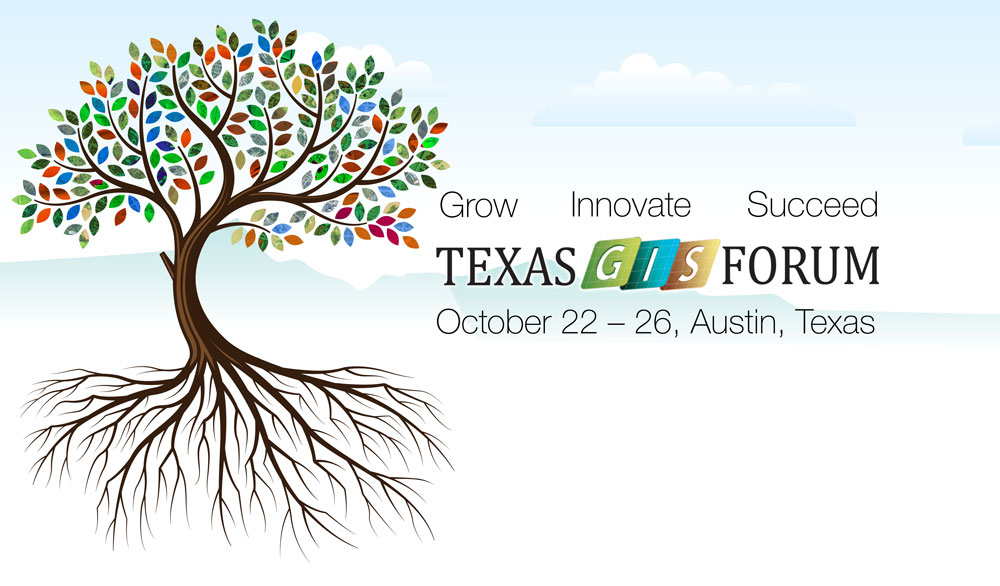

Day 1 - Monday, October 22
8:00 AM - 12:00 PM
Going Pro - ArcGIS Pro Essentials for Desktop Users - Hands On
Zena Pelletier, ESRI; Pamela Kersh, ESRI
Location: J.J. Pickle Research Center
8:00 AM - 12:00 PM
R for Data Visualization
Eric Pimpler, Geospatial Training Services
Location: TCEQ
1:00 PM - 5:00 PM
From Maps2Apps - Simple, Focused, Configurable, Off-the-Shelf Solutions - Hands On
Michael Beavers, ESRI
Location: J.J. Pickle Research Center
1:00 PM - 5:00 PM
Fundamentals of Census Geography and TIGER Topology
James Castagneri, U.S. Census Bureau; Lacey Loftin, U.S. Census Bureau
Location: J.J. Pickle Research Center
1:00 PM - 5:00 PM
Hands-on Satellite Imagery Analysis
Sara Safavi, Planet
Location: J.J. Pickle Research Center
Day 2 - Tuesday, October 23
8:00 AM - 12:00 PM
Integrating Census Data into GIS
James Castagneri, U.S. Census Bureau; Lacey Loftin, U.S. Census Bureau
Location: J.J. Pickle Research Center
8:30 AM - 4:30 PM
Field Operations with ArcGIS Apps
Chris LeSueur, ESRI
Location: J.J. Pickle Research Center
1:00 PM - 5:00 PM
Getting the Most From Your Lidar Data
Joey Thomas, TNRIS; Julie Parker
Location: J.J. Pickle Research Center
1:00 PM - 5:00 PM
How to Analyze and Visualize Spatial Data with CARTO Builder
Jeff Ferzoco, CARTO
Location: J.J. Pickle Research Center
Conference
Wednesday, October 24
Richard Wade, TNRIS Deputy Executive Administrator/State GIO
Keynote Presentation
Brian Unger, Actor, Comedian, Television Host
 Brian Unger, currently with the Travel Channel, has hosted across all media, including the History Channel's How the States Got their Shapes', and as a correspondent with Comedy Central's The Daily Show.
Brian Unger, currently with the Travel Channel, has hosted across all media, including the History Channel's How the States Got their Shapes', and as a correspondent with Comedy Central's The Daily Show.
10:00AM - 5:00PM
ESRI HOLL (FREE Hands-On Learning Labs)
Throughout the day on Wednesday, ESRI will host self-guided courses in the Balcones Room covering ESRI software and key GIS techniques.
Stay tuned for course offerings.
Session A (Big Tex)
Innovative Technologies I
10:30 – 11:00AM
Fast GIS on Managed Google Cloud
Sergei Kozyrenko, Parknav
11:00– 11:30AM
Improving Discovery and Access through Map Services at UT Libraries
Michael Shensky & Jessica Trelogan, University of Texas Libraries
11:30AM – 12:00PM
3D Mapping with Point Clouds
Sean Moran, Austin Community College
Session B (Li'l TEX)
Remote Sensing
10:30 – 11:00AM
Digital Image Revolution: The Future of Affordable, High-Quality Imagery as a Service
Randy Mayden, Hexagon Geosystems
11:00– 11:30AM
County-Scale Real-time Flood Response System using Lidar-derived Topography and National Water Model
Dr. Xing Zheng, University of Texas at Austin Center of Water and Environment
11:30AM – 12:00PM
Stereographic Compilation from UAS: An accuracy and feasibility study
Christian Stallings, McKim & Creed
Platinum Sponsor Presentation
Data Collection in the Field – Past, Present, and Future 
For centuries cartographers have been putting outdoor observations onto paper, and with GIS we moved to represent the real world as digital data objects. The real world is where the data resides, and at some point, we as humans need to interact with this real world to bring it into our GIS. From paper and clipboards to GPS, smartphones, wireless internet; we will discuss how field data collection has changed, where we are now, and what’s coming next.
Presenter: Chris LeSueur
Chris LeSueur is a Product Manager with the Apps Team in Redlands, California. He is responsible for managing Esri's mobile software products for smartphones, tablets, and rugged field devices. Chris has been with Esri for 18yrs working in various positions in Technical Marketing and Product Management. Before starting his career at Esri, Chris graduated from Brigham Young University with a degree in Geographic Information Systems.
Session A (Big Tex)
Tooling Around
2:00 – 2:30PM
NHD Markup Application
Claire DeVaughan, USGS
2:30 - 3:00PM
Advanced GIS Editing in the Web Browser with the Texas Water Service Boundary Viewer
Aubrey Drescher & Taylor Christian, TWDB
3:00 – 3:30PM
Cached Cow - How ArcGIS Online and Collector Saved Time and Resources in the Protection of the Edwards Aquifer
Sarah Eason, Edwards Aquifer Authority
Session B (Li'l TEX)
Public Utility Innovation
2:00 – 2:30PM
Use of LiDAR in Utility Data Extraction
Philip Burkhart & Lance Yarema & Dan Allee, City of Tyler
2:30 - 3:00PM
Solar Suitability Study Leads to Virtual Power Plant Testing
Jack Daly & Chris Foster, City of Georgetown
3:00 – 3:30PM
Mapping Rosenberg's Utilities
Cory Vardaman, City of Rosenberg
Session A (Big Tex)
SYSK (Stuff You Should Know)
4:00 – 4:30PM
Citizen Science: Power to the People
Matt Crawford, Texas A&M Natural Resources Institute
4:30 – 5:00PM
Growing Pains: Automating an ETL with Limited Resources
Jordan Carmona, City of McKinney
5:00 – 5:30PM
9-1-1 and GIS in the 21st Century – What You Should Know Now
Richard Kelly, 9-1-1 Datamaster
Session B (Li'l TEX)
Environmental Monitoring using GIS
4:00 - 4:30PM
Reimagining Land Management Assistance in Texas: Transforming TPWD’s Managed Lands Deer Program with Geospatial Technology
Jenn Sylvester, AppGeo | Chris Serny, TPWD
4:30 – 5:00PM
Increasing Awareness of Edwards Aquifer Endangered Species Habitat Restoration Through Interactive Web-map
Kristina Tolman, Edwards Aquifer Authority
5:00 - 5:30PM
Assessing the Extent and Landscape Structure of Sand Shinnery Oak Prairie in the Southern High Plains Using GIS and Remote Sensing: Challenges and Future Directions
Carlos Portillo-Quintero, Texas Tech University
Conference
Thursday, October 25
Keynote Presentation
Bill Johnson
Bill Johnson is AppGeo's 'Carpe Geo' Evangelist, an engaging speaker who shares his insights tying government initiatives to the most advanced GIS technology through collaboration, thoughtful investment, and consistent attention to excellence.
10:00AM - 4:00PM
ESRI HOLL (FREE Hands-On Learning Labs)
Throughout the day on Thursday, ESRI will host self-guided courses in the Balcones Room covering ESRI software and key GIS techniques.
Stay tuned for course offerings.
Session A (Big Tex)
Innovative Technologies II
10:30 – 11:00AM
Python and ArcGIS Online: Working with Python API for ArcGIS and Python REST API
Stephen Ross, Jacobs Engineering
11:00– 11:30AM
What's New in Automating GIS Workflows
Stephanie Long, Austin Community College
11:30AM – 12:00PM
Centimeter Accuracy GPS/GIS on Your Smartphone or Tablet
David Pritchard, Texian Geospatial and Asset Solutions
Session B (Li'l TEX)
Public Safety
10:30 – 11:00AM
GIS and Floodplain Management
Laura Pittman Haverlah, Atkins
11:00– 11:30AM
South By South Where – Exploring Data from 5 Years of Web Maps Developed for the Spring Festival Season
Mat Peck, City of Austin
11:30AM – 12:00PM
GIS In Community Risk Reduction
Ronald J. Vaughn, Dallas Fire Rescue
Platinum Sponsor Presentation
The Imprint of our GIS Heritage: Barton Springs Salamander, or Whitetail Deer? 
The theme of this year’s GIS Forum can be interpreted as two antecedents (Grow, Innovate) and a consequence (Succeed). Is our common GIS heritage a competitive advantage for achieving success as a profession, or are its idiosyncrasies constraining our fitness for adaptation? Our talk will extend the notions explored last year about operant conditioning vs. causal knowledge stemming from the “Crow and the Pitcher” story; and share some thoughts on the competing criteria for progress if we are to successfully evolve. Are we conditioned for success or failure in terms of our evolution as geospatial professionals, and what are the conscious choices we can make to adapt? We will also suggest some unifying goals for our profession, and discuss the trajectory they could put us on.
Session A (Big Tex)
Modeling Our Environment
2:00 – 2:30PM
People, The Environment & GIS - Development of San Antonio's Brooks Regional Center
Sara Mendiola, San Antonio River Authority
2:30 - 3:00PM
From 0-Dimensional data to information in 3D
Miguel Pavon, Texas Water Development Board
3:00 – 3:30PM
2D and 3D Edwards Aquifer Structural Visualization
Ned Troshanov & Sarah Eason, Edwards Aguifer Authority
Session B (Li'l TEX)
UAS Sensor and Sensibility
2:00 – 2:30PM
Generating a 3D Point Cloud from UAV Images
Kris Berglund, Blue Marble
2:30 - 3:00PM
Environmental Science Public Ownership GIS/UAS Primer
Andrew Vanderheiden, Texas A&M University | Katie Strain, University of Texas at Austin
3:00 – 3:30PM
UAS data and 3D Printing for land surface modeling
Dr. Yanli Zhang & Daniel Unger & I-Kuai Hung, Stephen F. Austin State University
Break & Exhibits
Lightning Talks
We'll end the day with **Lightning Talks**, where any Forum attendee can step up to present. If you have something quick to share, come prepared with an idea of what you could present within a short 5-minute time slot and sign up for a lightning talk on-site at the event.
Lightning Talk Rules- 5 minutes max – We will tightly enforce this.
- No external computer laptops or tablets - only browser based access to materials and links.
- Tips: Understand your topic – make your point at the beginning. You don't have to use all 5 minutes.
Closing Remarks - Richard Wade, TNRIS Deputy Executive Administrator/GIO
Conference
Friday, October 26
Town Hall: State of the State
Federal Activity Updates with State Impact
New State Plane 2022, Next Generation 9-1-1, Geospatial Data Act, Geo-Enabled Elections
Town Hall: State of the State Cont'd
State Initiatives and Data Priorities
Parcels, Address Points, Future Lidar Roadmap, Texas Orthoimagery Program, Texas Imagery Service, and the National Agriculture Imagery Program












